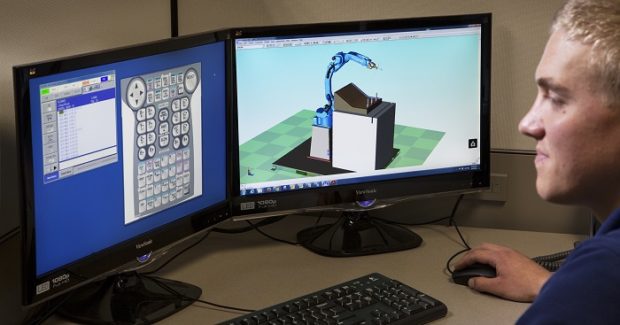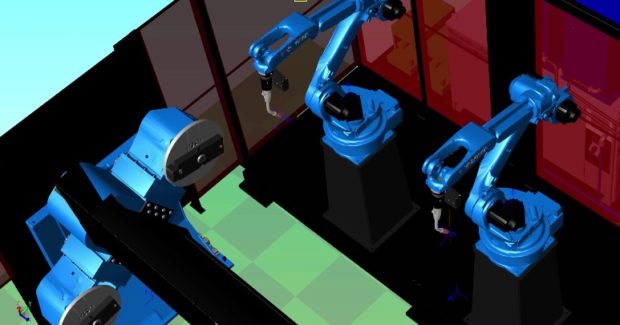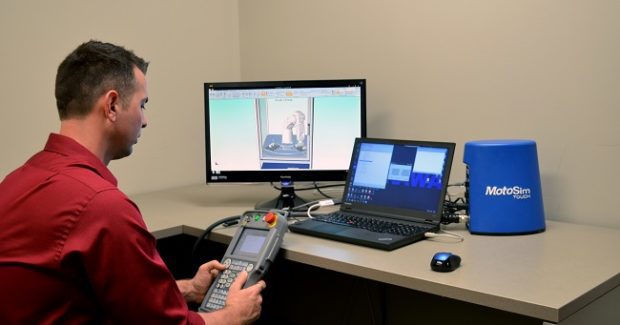Robotic Simulation to Bridge the Skills Gap
Because robots still only do what they are programmed to do and still require qualified personnel to build, operate and maintain them, savvy shops realize that creating a workforce skilled in Industry 4.0 technologies is key to future competitiveness – but certain challenges make this difficult. What should they do?
Posted: October 22, 2018
While advancements in industrial robotic technology have greatly enhanced application capabilities in the last decade, robots still only do what they are programmed to do, still requiring qualified personnel to build, operate and maintain them. With 1.7 million new industrial robots expected to be installed into production factories worldwide by 2020, savvy decision makers in diverse industries are realizing that the creation of a sustainable workforce, proficient in Industry 4.0 technologies, is key to future operational productivity.1 Achieving and maintaining a skilled workforce of this nature, however, does not come without certain challenges.
EDUCATIONAL CHALLENGES
Despite successful on-going initiatives to educate students in science, technology, engineering and math (STEM), a recent Deloitte study reports that the manufacturing job gap, at its current pace, will continue to grow to a shortage of two million workers over the next decade.2 This means it is imperative for training organizations and educational research institutions to provide a fully functional production environment where students have the ability to gain hands-on experience. Similarly, some companies that are turning to robotic automation to increase productivity and improve quality are realizing that a seamless and successful integration process may entail redeploying and educating current workers about robot programming, modeling and diagnostics. The trend of creating a robotic “workcell champion” – where an employee is trained to be fully dedicated to robot programming and utilization within an organization – is aiding companies in their quest to stay a step ahead of competitors.
Whether a company is hiring new workers or training talent within, accomplishing the desired level of success requires companies to make investments in advanced technologies and educational tools.
SMART SOLUTIONS
In an effort to help manufacturers retain and hire the needed talent to meet organizational goals, robotic manufacturers like us are creating workforce development-driven systems to bridge the gap between the education community and the industrial sector:
- Programming Modules. Programming modules such as our MotoSim Enhanced Graphics – Virtual Robot Controller (MotoSim EG-VRC) can teach programmers, engineers and service personnel the fundamentals of robot cell development and offline programming concepts. Based on popular robot controller models, this type of software allows users to create a realistic representation of a conceptual design. Furthermore, this highly-accurate simulation tool for advanced control capabilities between robots and positioners allows users to become proficient with a wide variety of robot functions. From enhanced multiple robot control to external axis control and coordination and more, offline programming of complex systems in this manner provides multiple benefits to shops seeking to fulfill diverse application requirements. Programs created in software of this nature can be downloaded to the robot controller, reducing programming time and increasing production uptime on the factory floor.
- Educational Tools. Certain educational products, such as our MotoSim Touch, allow students to toggle between a virtual pendant and a hardware pendant, delivering a “real world” virtual robotics experience apart from the shop floor. This comprehensive package includes offline programming and simulation software (MotoSim EG-VRC for Education) to provide students with accurate 3D simulation of robotic workcells. From collision detection and reach analysis to cycle time calculations, a tool of this nature has the potential to help students learn the skills needed for multiple process applications including arc and spot welding, cutting, handling, painting and sealing. As an added benefit, students can also save programming from the simulation environment to a flash drive, so that it can be used on the classroom robot.
COMPETITIVE ADVANTAGE
Not only can the utilization of these types of programming modules and educational tools garner respect from current employees, but use of such tools can also foster a strong competitive advantage. Offline cell design can minimize fixturing errors and reduce robot installation time, and offline programming and testing reduces robot downtime and increases production uptime on the factory floor. And, while investing in advanced technologies and education tools is a logical next step for bridging the skills gap for training organizations and manufacturers alike, having a detailed plan for robotic automation implementation with well-defined goals and training strategies is critical for operational success.
References
1. IFR World Robotics 2017, International Federation of Robotics (IFR), 2015
2. The Skills Gap in U.S. Manufacturing, Deloitte, 2015















